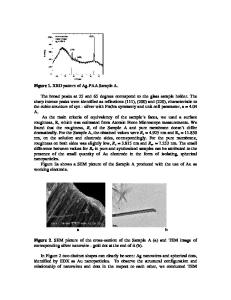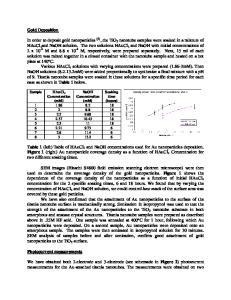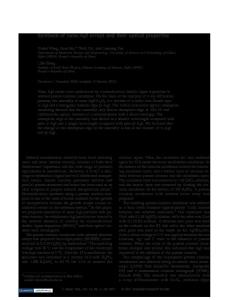Eu-Doped Silica Nanotubes: Synthesis and Optical Properties
- PDF / 2,227,676 Bytes
- 6 Pages / 612 x 792 pts (letter) Page_size
- 68 Downloads / 367 Views
0922-U01-03
Eu-Doped Silica Nanotubes: Synthesis and Optical Properties Catherine Murphy, and Simona E. Hunyadi Chemistry and Biochemistry, University of South Carolina, 631 Sumter St., Columbia, SC, 29208 ABSTRACT Silver nanowires were coated with a silica shell through an indirect approach. Incorporation of the fluorescent ion into the silica shell in situ was achieved. Subsequent chemical dissolution of the inner metal core resulted in fluorescent silica nanotubes. Transmission electron microscopy (TEM), electron dispersive X-ray microanalysis (EDAX), fluorescence spectroscopy, and zeta potential measurements were used to characterize the materials.
INTRODUCTION Today, the research for the development of hollow fluorescent colloids is driven by their distinctive properties such us ability to encapsulation, high surface area, and tunable structural, optical and surface properties, etc. Materials at nanometer scale with tailor made porosity, morphology, and chemical functionality are particularly interesting in the development of novel luminescent probes for both drug delivery and imaging [1-4], separation and/or transport of molecules (nanofluidics) [5] purposes due to their size comparable to biomolecules and their novel optical, electronic, and magnetic properties. Moreover, the use of different sizes and shapes of silica as templating/scaffolding directing-agent is a prospective avenue for the production of various structures in vivo (e.g. functionalized C60, fullerene, R5 polypeptide, PLL poly-1-lysine, and PAH poly(allylamine hydrochloride) [6]. Silica is an excellent host material due to the fact that is highly porous, easily to functionalize, nontoxic and biocompatible material and can be exploited for biological applications. The sol-gel process used for synthesis of silica glasses doped with Eu(III) is a convenient approach due to the ability to produce different doping compositions with a good chemical stability, low thermal expansion coefficient, high refractive index and efficient emitter properties [7-9]. Europium complex-based fluorescence labels can be used for highly sensitive time-resolved fluorescence immunoassay, DNA hybridization assay, cell activity assay, and bioimaging microscopy assay [10-12]. In this study we report the synthesis of high aspect ratio silica nanotubes doped with Eu(III). Also, silver-silica nanoparticles doped with Eu(III) were used for comparison. Our methodology involves a facile and flexible two step sol-gel approach with different Eu(III) loading in the silica. Optical properties of europium doped silica nanocomposite materials with different loading concentrations were explored.
EXPERIMENTAL DETAILS
Silver nanowires were prepared in water, in the absence of surfactant or polymer, and without externally added seed crystallites, as described elsewehere [13]. Basically, a typical synthesis requires the combination of two silver solutions. The first solution consisted of 100 mL deionized water, 1.5 L of 0.1M NaOH, and 40 L of 0.1M AgNO3. This solution was brought to a
Data Loading...









